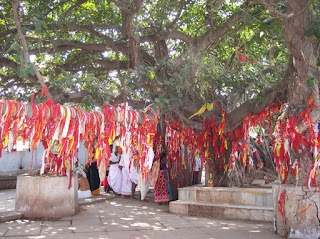I have been living in Allahabad
Did you know?
The 82½ degrees East Longitude by which India Zero Road , Allahabad
The city of Allahabad is among the largest cities of Uttar Pradesh and situated at the confluence of three rivers - Ganga , Yamuna and the mythical Saraswati. the meeting point is known as Triveni and is especially sacred to Hindus. The earlier settlements of the Aryans were established in this city, then known as "Prayag" 'Prayagasya Praveshu Papam Nashwati Tatkashanam.' All sins are cleaned with entry in Prayag (the ancient name of modern time Allahabad India
Its sanctity is manifested by references to it in the Purans, the Ramayan and the Mahabharata. According to Hindu Mythology, Lord Brahma, the creator God of the Trinity, chose a land on earth (i.e. Prayag) to perform the 'Prakrista Yag', at the beginning of the creation and he also referred to it as the Tirth Raj or the King of all pilgrimage centers. As per the writings of 'Padam Puran' - "As the sun is amongst the moon and moon is amongst the stars, likewise 'Prayag is best amongst all places of pilgrimage'.
The bathing at Prayag is mentioned in Brahma Puran as "in the month of Magha at the bank of Ganga-Yamuna in Prayag bestows results of millions and millions of Ashvamedha Yajna". Prayag is the birth place of Som, Varuna and Prajapati. Prayag has been associated with mythological personalities in Brahman cal (Vedic) and Buddhist Literatures. It was the seat of the great sage Bhardwaj, Sage Durvasa and Sage Pannas. Sage Bhardwaj lived here circa 5000 B.C. and taught more than 10000 disciples. He was the greatest philosopher of ancient world.
The present Jhunsi area, close to Sangam, was the kingdom of Chandrabanshiya (lunar clan) King Pururava. Nearby Kaushambi bloomed to prosperity during Vatsa and Maurya Rule. The earliest monument of the antique Ashok Pillar with inscriptions of third century B.C. bears the inscriptions of his directions to his fellow rajas and praise of King Samudragupta. The Chinese traveller Huen Tsang in 643 B.C. found Prayag inhabited by many Hindus who regarded the place very Holy.
SANGAM
Around 7 Km from Civil Lines, overlooking the eastern ramparts of the fort, wide flood plains and muddy banks protrude towards the sacred Sangam. At the point at which the brown Ganges meets the greenish Yamuna, pandas (priests) perch on small platforms to perform puja and assist the devout in rituals and ablutions in the shallow waters. Beaches and ghats are littered with the shorn hair of pilgrims who come to offer 'pind' for their deceased parents. the sacred Sangam is the confluence of three of the holiest rivers in the Hindu Mythology ~ Ganga , Yamuna, and the mythical Saraswati. At the Sangam, the waters of the Ganges and the Yamuna can be distinctly seen merging into one. It is during the Kumbh/Ardh Kumbh that the Sangam truly comes alive attracting the devout from all across the country. The holy Sangam is the site for the Annual Magha Mela/Ardh Kumbh/Kumbh Mela. Boats are available.
While there at Sangam I also gleaned some information on the World Famous Kumbh Mela.
KUMBH MELA
Hindus, traditionally regard river confluences as auspicious places, more so the Sangam at Allahabad , where the Yamuna and the Ganges meet the 'River ofEnlightenment', the mythical Saraswati. According to legend, Vishnu was carrying a kumbh (pot) of amrit (nectar), when a scuffle broke out between the Gods, and four drops were spilled. they fell on the earth at the four tirthas of Prayag, Haridwar, Nasik and Ujjain
Of still great interest, apart from the other monuments hitherto described, is the celebrated Patalpuri temple, the only relic of ancient Prayag and one of the most ancient Hindu buildings in the United Province
AKSHAYA VAT
An ancient looking Banyan tree, situated in the A E & S sub depot of the fort, is of immense historical and religious importance, primarily, due to its revered place in the Hindu religion and the immense importance given by historians of all ages depicting the sacred role it assumed in the system of religious belief of the Hindus. The famous Chinese traveler Huien Tsang, visited Prayag in 644 AD. He writes: before the hall of temple, is the reservoir, it is said that the construction of the fort obliterated the Kanya Kup or the deep reservoir.
Thus, the age of the tree, despite its mentioning by many writers, the Puranas and Ramayan, as yet, remains devoid of scientific and historical antecedents. It can reasonably be concluded from the historical stages that the tree has been shifting its location, scientifically proved that the Banyan species is known for extending its roots. One such root has damaged the outer wall of the fort near the corner of fortress wall which meets the basin of Ganges
HANUMAN MANDIR
Near the Sangam, this temple is unique in North India , for its supine image of Hanuman. Here the big idol of Lord Hanuman is seen in a reclining posture. When the Ganga is in spate, this temple gets submerged.
One of the most happening places in Uttar Pradesh and North India, Allahabad
- Anupam Mujumdar, Student Intern, Parihara.com















That was a great trip! I'm still sitting in the time-machine... Where is the next journey to ?
ReplyDelete